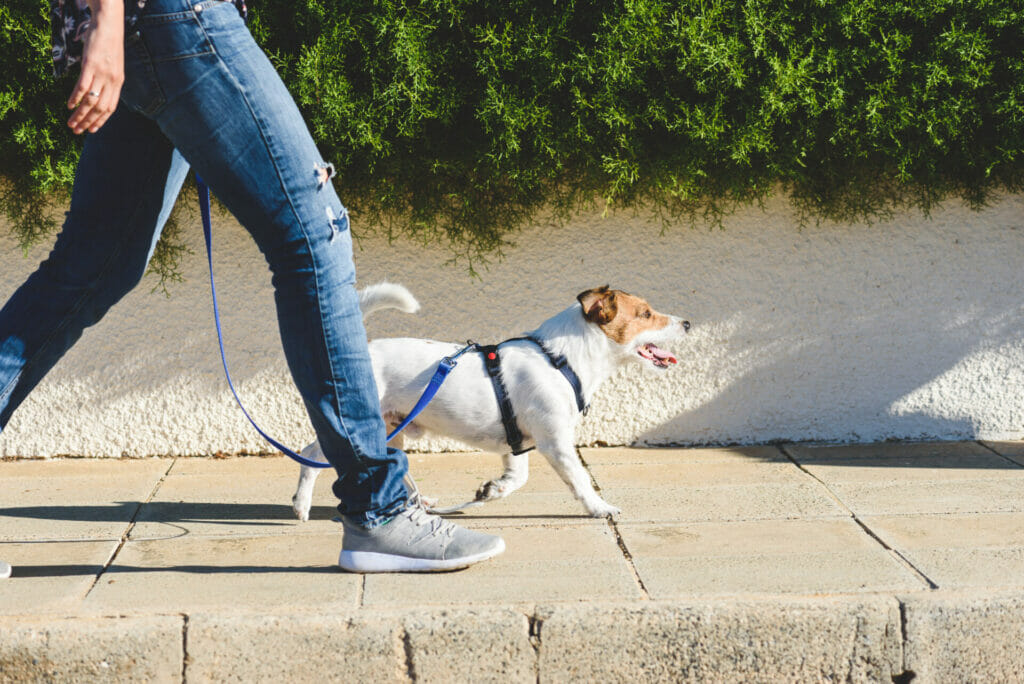Does your dog beg to go walking? Many dogs love to walk and start getting excited anytime their leash gets pulled out and seem to want to walk as long as you’ll let them. Although many dogs like to walk, it is possible for dogs to have too much of a good thing. When it comes to walking your dog, how much should you be walking your dog?

Consider Age For Walking Dog:
Young puppies might seem like they have lots of energy, but limiting how much walking and other structured exercise is important. The joints of young puppies are still physically developing, and too much exercise at a young age can cause long-term orthopedic injuries. Talk with your dog’s veterinarian and breeder about how much walking is ok for your breed of puppy and their age. With large and giant breed puppies, you’ll especially want to limit how much walking your dog does as their joints are still growing and developing. Some large breeds don’t finish growing until they are two years old.
When your dog gets older, you may also need to be thoughtful about how often or far you walk. Especially for senior dogs who have arthritis or other degenerative conditions, you may need to start walking slower or taking your dog on shorter or less frequent walks. Walking long distances can be uncomfortable if your older dog has any orthopedic conditions. On the other hand, walking can help older dogs maintain high levels of physical fitness and support graceful aging. The amount of walking your senior dog should be doing will be unique to your dog’s specific health, and what your veterinarian recommends is best.
Health First:
If you haven’t been walking your dog a lot or they don’t seem enthusiastic about walks, it’s important to schedule an appointment with your dog’s veterinarian before changing their walking regimine. Your dog’s veterinarian will be able to fully evaluate your dog’s overall health to determine if your dog has any pre-existing conditions that might limit the amount of walking exercise your dog can have. Your vet will be able to let you know how much your dog can safely walk. If your vet has concerns about your dog walking, they may refer you to a veterinary physical therapist for further evaluation. A veterinary physical therapist will be able to assess your dog’s overall orthopedic health and develop a physical therapy routine that will help get your dog back up and walking more comfortably.
Build-Up Endurance:
Walking is an excellent source of exercise for dogs and can be a relatively low-impact way to help improve your dog’s overall levels of physical fitness. However, it’s important to be thoughtful about how you start to increase the amount of physical exercise that your dog is getting. Talk with your dog’s veterinarian about if your dog has any restrictions on physical activity or fitness considerations that you should be considering when starting to exercise your dog more. Assuming your dog is healthy and ready to walk, start by walking your dog for 10-15 minutes once or twice a day. When your dog is comfortable walking that distance, you can slowly increase your walking time. Even if your dog seems to have lots of energy, it’s a good idea to build their strength and stamina to prevent strain and injury.
Check The Weather For Walking Dog:
The amount of walking your dog should do will also be seasonally dependent. If weather conditions are very cold or very hot, you’ll want to limit how much time you spend walking your dog. Hot weather can make sidewalks and streets dangerously hot, and can burn your dog’s feet. Walking in hot weather can also exhaust your dog and lead them to overheat. In cold weather, dogs can become too cold while out walking. Salt and chemical deicers are frequently put out on sidewalks and streets in the winter, which can irritate and even burn your dog’s paw pads.
It’s Ok Not to Walk:
If you have a dog who is uncomfortable or distressed on walks, it’s perfectly ok to limit how much you walk your dog or even stop walking regularly. If walking is upsetting for your dog, finding a dog trainer who utilizes positive reinforcement approaches to help you build your dog’s comfort and confidence in walking with plenty of treats is a good idea. In the meantime, if walking is upsetting for your dog or not something you enjoy, try to find other forms of mental and physical exercise and enrichment that you can incorporate into your dog’s daily routine. If at any point while you are walking your dog, you find that your dog seems physically uncomfortable or in pain, end your dog’s walk right away. If stiffness and soreness persist, contact your dog’s veterinarian. Your dog’s veterinarian will be able to determine if there are any underlying health conditions that are causing pain or discomfort and let you know when it’s safe to begin walking again.




















